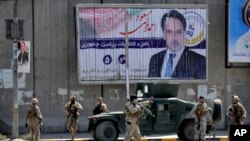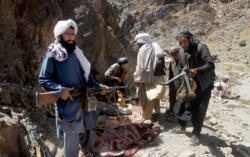Prospects for peace in Afghanistan appeared more remote Thursday after an early morning Taliban suicide car bomb attack on a government building in southern Afghanistan killed at least 15 people, bringing to more than 70 the death toll in such attacks this week. The violence is expected to increase further as Taliban insurgents have warned of attacks on polling centers just days ahead of the country’s planned presidential elections.
The latest spate of bombings across Afghanistan, including an attack earlier this week targeting President Ashraf Ghani, follow the collapse of peace talks between the United States and the Taliban.
Moreover, there are the concerns that the ever-growing anger and animosity may make it that much more difficult that an eventual deal, including the Afghan government, if reached, will ever take hold.
Of particular concern to some U.S. officials is the fate of about 60,000 full-time Taliban fighters who would be forced to lay down their weapons and find a new way of life, likely within the communities they once battled.
“The reintegration of former fighters into society — a complex and long-term process with social, economic, political, security and humanitarian dimensions —will be critical for Afghanistan to achieve lasting peace and stability, a goal crucial to U.S., coalition and Afghan interests,” according to a newly released report by the Office of the Special Inspector General for Afghanistan Reconstruction (SIGAR).
How to employ former fighters?
The challenge will be massive. In addition to the full-time Taliban fighters, U.S. officials estimate there are 90,000 seasonal fighters, some of whom may also need to be integrated into the workforce.
Making prospect all the more daunting, Afghanistan’s economy is struggling, stifled in part by an ongoing drought and facing slowing growth and high levels of unemployment.
U.S. officials also worry about pervasive government corruption and the allure of criminal networks making money from illegal drugs.
Put together, it is enough for SIGAR to warn that conditions are “not conducive to a successful reintegration program.”
Failure to eventually reintegrate tens of thousands of Taliban fighters, should the Taliban and the Afghan government ever reach an agreement, could also be costly.
“If ex-combatants are not accepted by their communities or are unable to find a new livelihood, they may be vulnerable to recruitment by criminal groups or terrorist organizations like the Islamic State Khorasan, the local branch of the Islamic State active in eastern Afghanistan,” the report warns.
Peace talks dead
However, such challenges may still be far off.
The White House this week labeled the latest Taliban attacks, which killed almost 30 civilians at an election rally in Parwan province, “cowardly.”
U.S. President Donald Trump “has made clear that he will not negotiate a peace agreement while the Taliban continues such attacks,” the statement said.
Afghan government officials have also bristled, repeatedly, at the way negotiations between the U.S. and the Taliban have played out, with the government sidelined in the initial talks.
“The people of Afghanistan and their elected representatives have been eager to engage in a meaningful peace process,” Afghan Ambassador to the U.S. Roya Rahmani, told a Washington audience last week.
“We know peace is on the horizon,” she added. “We also know it will come on our terms.”
Forcing US out
Meanwhile, the Taliban have been reaching out to U.S. adversaries such as Russia, China and Iran in the hopes of finding ways to force the U.S. to leave Afghanistan.
“The purpose of these visits is to inform leaders of these countries about the peace talks and President Trump’s decision to call off the peace process at a time when both sides had resolved all outstanding issues and were about to sign a peace agreement,” a senior Taliban official in Qatar said Wednesday.
The developments have some former U.S. military officials warning reconciliation and reintegration may not be possible for the foreseeable future.
“I never thought negotiations with the Taliban were a good way to go,” former U.S. Special Operations Command Commander, retired Admiral William McRaven, said during a forum in Washington Wednesday.
McRaven, perhaps best known for overseeing the raid that led to the death of al-Qaida founder Osama bin Laden in Pakistan in 2011, warned the U.S. military will have to stay in Afghanistan to counter the Taliban for years to come.
“If we negotiate some sort of settlement with the Taliban and that settlement calls for the withdrawal of all U.S. troops from Afghanistan, it won’t be six months or a year before all the blood and treasure we have put into Afghanistan will have been reversed,” he said.












